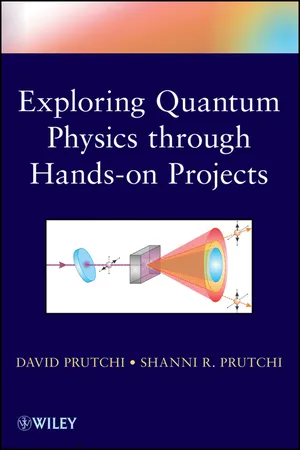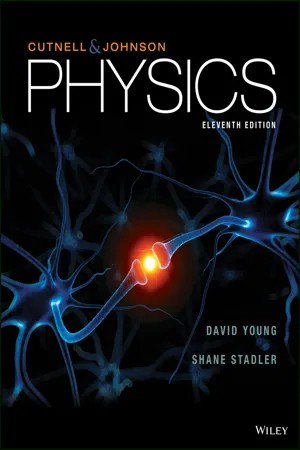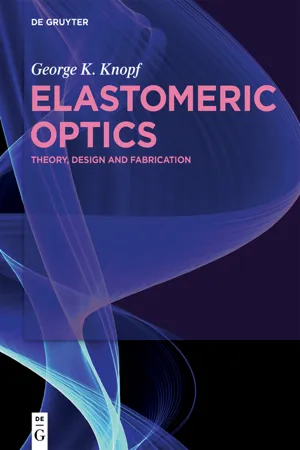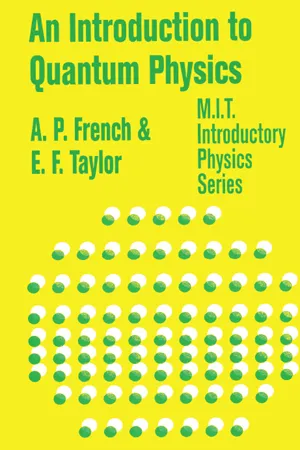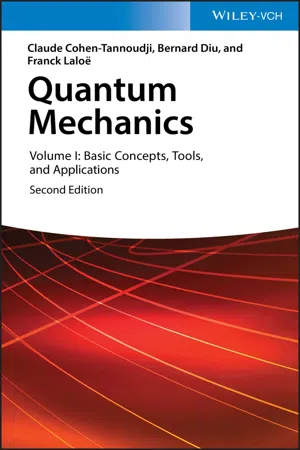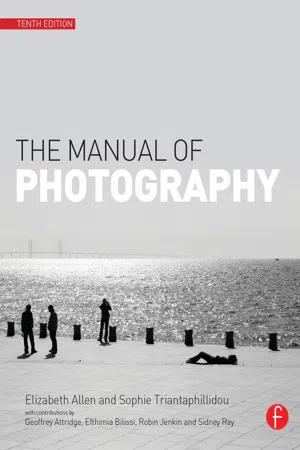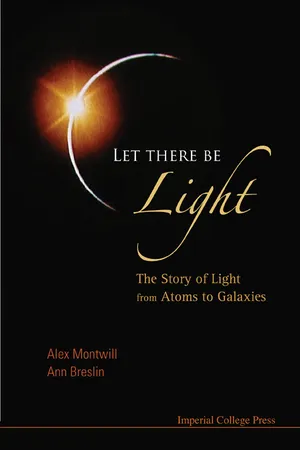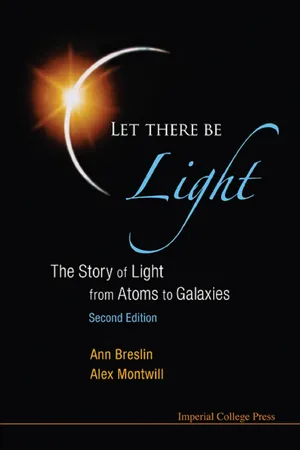Physics
Wave Particle Duality of Light
The wave-particle duality of light is a fundamental concept in physics that describes the dual nature of light as both a wave and a particle. This duality is demonstrated through phenomena such as diffraction and interference, which are characteristic of waves, as well as the photoelectric effect, which is characteristic of particles. This concept revolutionized our understanding of the behavior of light at the quantum level.
Written by Perlego with AI-assistance
Related key terms
Related key terms
1 of 4
Related key terms
1 of 3
11 Key excerpts on "Wave Particle Duality of Light"
- eBook - ePub
Making Physics Fun
Key Concepts, Classroom Activities, and Everyday Examples, Grades K?8
- Robert Prigo(Author)
- 2015(Publication Date)
- Skyhorse(Publisher)
So the particle picture of light was back on the scene. Indeed, the nature of light turned out to be much more interesting than an either-or particle or wave reality. Both descriptions are needed for a full picture of light. This complementary picture is known as the wave-particle duality for light. The dual nature of light, propagating as an electromagnetic wave while interacting with matter through particle-like photons, sums up our present understanding of light. This wave-particle duality is now known to be a universal property of nature. Based on an analogy with the dual nature of light, Louis de Broglie (1892–1987) proposed that matter itself (electrons, atoms, etc.) might show the same duality. He proposed that particles such as electrons might have wave-like features. His ideas were soon put to the test and vindicated when experiments revealed the diffraction and superposition of electrons! All forms of light, both visible and nonvisible, share many fascinating characteristics and properties. Light does not need a medium through which to propagate. It can propagate in a vacuum. Light is made up of oscillating and self-sustaining electric and magnetic fields that interact with matter in a particle-like way (photons). Light travels at a constant speed in a vacuum (299,792,458 meters per second). In a transparent material, light travels at a slower speed, with different frequencies traveling at slightly different speeds. In a vacuum and in uniform transparent materials, light travels in straight lines. Some objects reflect light, some absorb light, and some do both. Light bends— refracts —when it propagates from one transparent medium into another. Visible light comes in a narrow but continuous spectrum of frequencies that we detect as different colors (red to violet). “White” light is composed of light of different colors (red to violet). “Black” is the absence of light - eBook - ePub
- Zbigniew Ficek(Author)
- 2017(Publication Date)
- Jenny Stanford Publishing(Publisher)
Chapter 6 Duality of Light and MatterIf all this damned quantum jumps were really to stay, I should be sorry I ever got involved with quantum theory.—Erwin SchrödingerWe have already encountered several aspects of quantum physics, but in all the discussions so far, we have always assumed that a particle, a photon in particular, is a small solid object. However, quantum physics as it developed in the three decades after Planck’s discovery, found a need for an uncomfortable fusion of the discrete and the continuous. This applies not only to light but also to particles. Arguments about particles or waves gave way to a recognized need for both particles and waves in the description of radiation. Thus, we will see that our modern view of the “true nature” of radiation and matter is that they have a dual character, behaving like a wave under some circumstances and like a particle under other, but never both simultaneously.In the last few chapters, we discussed the wave and particle properties of light, and with our current knowledge of the radiation theory, we can recognize the following wave and particle aspects of radiation:The fact that the same light beam can behave like a wave and a particle raises tricky questions. How can light be a wave and a particle at the same moment? Is a photon a particle or a wave? Evidently, we are left with an obvious question: Which theory are we to believe? If we accept the duality of light, then another obvious question arises: Is this dual character a property of light alone or of all structures in the universe, in particular material particles? Following this, one may ask: Is an electron really a material particle or is it a wave?Wave characterParticle character1. Polarization Photoelectric effect 2. Interference Compton scattering 3. Diffraction Blackbody radiation We have to say that there is no definite answer to these questions. We can get a satisfactory answer to these questions, but we must enter the strange and often deceiving world of quantum wave physics - David Prutchi(Author)
- 2012(Publication Date)
- Wiley(Publisher)
Light apparently is something different altogether, but it behaves as a wave when the experiment is designed to reveal its wave-like properties, while it behaves as a particle when the experiment is designed to show its particle-like properties. This schizophrenic personality of light is known as the “wave–particle duality.” The type of experiment will show either light’s particle-like or wave-like behavior, but not both at once, which made Niels Bohr state that the wave and particle aspects of light are complementary to each other. The concept of complementarity derives directly from wave–particle duality, and states that all physical reality is determined and defined by manifestations of properties that are limited by trade-offs between complementary pairs of these properties. MATTER WAVES Even in the light of the Compton Effect, critics of the early single-photon interference experiments dismissed the importance of the observation by noting that a photon doesn’t have mass. Through some fancy hand-waving, they argued that the low-light interference could be caused through splitting and recombining the light quanta’s wavefront. Decisive proof would come when particles with mass would show interference. In 1924, French physicist Prince Louis-Victor de Broglie (pronounced “de Broy,” and by the way, he did belong to the French royalty) proposed that maybe it’s not just light that has this dual personality, maybe it’s everything! He reasoned that if the quanta of light could be both a wave and a particle, then maybe the same could be true of electrons. Remember that although a photon doesn’t have mass, it does have momentum p given by: De Broglie’s hypothesis was that matter—which is commonly described by our perception as “solid”—can also behave as a wave- eBook - ePub
- John D. Cutnell, Kenneth W. Johnson, David Young, Shane Stadler(Authors)
- 2018(Publication Date)
- Wiley(Publisher)
CHAPTER 29Particles and WavesThis photograph shows a highly magnified view of a female mosquito, made with a scanning electron microscope (SEM). In the twentieth century, physicists were astonished when it was discovered that particles could behave like waves. In fact, we will see in this chapter that there is a wavelength associated with a moving particle such as an electron. The microscope used for the photograph takes advantage of the electron wavelength, which can be made much smaller than that of visible light. It is this small electron wavelength that is responsible for the exceptional resolution of fine detail in the photograph.LEARNING OBJECTIVES
After reading this module, you should be able to…- 29.1 Define wave-particle duality.
- 29.2 Explain the origin of Planck's constant from blackbody radiation.
- 29.3 Use photon energy to explain in detail the photoelectric effect.
- 29.4 Use photon momentum to explain in detail the Compton effect.
- 29.5 Solve problems involving the de Broglie wavelength of a particle.
- 29.6 Calculate quantum uncertainty using the Heisenberg uncertainty principle.
29.1 The Wave–Particle Duality
The ability to exhibit interference effects is an essential characteristic of waves. For instance, Section 27.2 discusses Young's famous experiment in which light passes through two closely spaced slits and produces a pattern of bright and dark fringes on a screen (see Figure 27.3 ). The fringe pattern is a direct indication that interference is occurring between the light waves coming from each slit.One of the most incredible discoveries of twentieth-century physics is that particles can also behave like waves and exhibit interference effects. For instance, Interactive Figure 29.1 shows a version of Young's experiment performed by directing a beam of electrons onto a double slit. In this experiment, the screen is like a television screen and glows wherever an electron strikes it. Part a of the drawing indicates the pattern that would be seen on the screen if each electron, behaving strictly as a particle, were to pass through one slit or the other and strike the screen. The pattern would consist of an image of each slit. Part b - eBook - ePub
Elastomeric Optics
Theory, Design, and Fabrication
- George K. Knopf(Author)
- 2022(Publication Date)
- De Gruyter(Publisher)
s equivalent to(2.5)E=m a s sm a s s×s p e ed 2where the speed of light in a vacuum is constant. When light behaves as a wave, however, it has an energy that is proportional to its frequency fυ λ= 2.99 ×10 8m / s(2.6)By simultaneously assuming that an object can be both a particle and a wave, de Broglie set up the following equationE= h f = hw a v eυ λλ(2.7a)E=m a s sEw a v eo rmυ λ 2=hλυ λ(2.7b)λ ==h υmυ λ 2h=mυ λh pRearranging this equation, he derived a relationship between one of the wave-like properties of matter and one of its properties as a particle. Note that the momentum p of the particle is the product of the object mass times its speed. Thus, the de Broglie equation suggests that the wavelength λ of any object in motion is inversely proportional to its momentum p .Louis-Victor de Broglie concluded that most particles would be too heavy to observe their wave properties. When the mass of an object is very small, however, the wave properties can be detected. He predicted that the mass of an electron was small enough to exhibit the properties of both particles and waves. In 1927 this prediction was confirmed when the diffraction of electrons was observed experimentally by Clinton J. Davisson. de Broglie applied his theory of wave-particle duality to the Bohr model to explain why only certain orbits are allowed for the electron. He argued that only certain orbits allow the electron to satisfy both its particle and wave properties at the same time because only certain orbits have a circumference that is an integral multiple of the wavelength of the electron. - eBook - ePub
- A.P. French(Author)
- 2018(Publication Date)
- Routledge(Publisher)
3 Wave-particle duality and bound states 3.1 PRELIMINARY REMARKSIn Chapter 2 we described the theoretical and experimental bases for ascribing a definite wavelength to particles of a given momentum. This development involved the recognition of some very basic similarities between the descriptions of light propagation and the motion of material particles. We shall now take up the question of what sort of wave equation can be devised for material particles that will embody these similarities and enable us to extend particle dynamics into the atomic domain.Our starting point is the knowledge that light waves are characterized by two parameters—wavelength λ and frequency v. The description of light as photons relates these classical parameters to the quantized values of energy E and momentum p for individual photons:λ =h p;E = h vNow in Chapter 2 we saw that the first of these relationships applies to material particles as well as to photons. Our next step is to introduce the postulate that the second relationship is equally general, so that the motion of a particle of momentum pand energy E will be described by a wave of wavenumber k and angular frequency ω, where=k ==2 πλ;2 π phω = 2 π v2 π EhIf we can find the value of E in any given case, we can, according to this new postulate, infer the value of ω through the relationshipE =hω = ℏ ω2 π(3-1) Recall (Eq. 1-29 ) that the symbol ħ is an abbreviation for h/2π. Using this same notation, the original de Broglie relationship for moving particles can be writtenp = ℏ k(3-2) Equations 3-1 and 3-2 will be the basis for constructing an equation for particle waves.Any wave equation that we develop must embody the correct dynamical relationship between E and p. In classical (nonrelativistic) mechanics, this relationship comes directly from the statement that the total energy of a particle is the sum of its kinetic energy p2 /2m and its potential energy V - eBook - ePub
Quantum Mechanics, Volume 1
Basic Concepts, Tools, and Applications
- Claude Cohen-Tannoudji, Bernard Diu, Franck Laloë(Authors)
- 2020(Publication Date)
- Wiley-VCH(Publisher)
hv. Einstein showed how the introduction of photons made it possible to understand, in a very simple way, certain as yet unexplained characteristics of the photoelectric effect. Twenty years had to elapse before the photon was actually shown to exist, as a distinct entity, by the Compton effect (1924).These results lead to the following conclusion: the interaction of an electromagnetic wave with matter occurs by means of elementary indivisible processes, in which the radiation appears to be composed of particles, the photons. Particle parameters (the energy E and the momentum p of a photon) and wave parameters (the angular frequency ω = 2πυ and the wave vector k, where |k| = 2π/λ, with v the frequency and λ the wavelength) are linked by the fundamental relations:(A-1)where is defined in terms of the Planck constant h:(A-2)During each elementary process, energy and total momentum must be conserved.A-2. Wave-particle duality
Thus we have returned to a particle conception of light. Does this mean that we must abandon the wave theory? Certainly not. We shall see that typical wave phenomena such as interference and diffraction could not be explained in a purely particle framework. Analyzing Young’s well-known double-slit experiment will lead us to the following conclusion: a complete interpretation of the phenomena can be obtained only by conserving both the wave aspect and the particle aspect of light (although they seem a priori irreconcilable). We shall then show how this paradox can be resolved by the introduction of the fundamental quantum concepts.A-2-a. Analysis of Young’s double-slit experiment
The device used in this experiment is shown schematically in Figure 1 . The monochromatic light emitted by the source ℐ falls on an opaque screen 𝓅 pierced by two narrow slits F1 and F2 , which illuminate the observation screen ℰ (a photographic plate, for example). If we block F2 , we obtain on ℰ a light intensity distribution I1 (x) which is the diffraction pattern of F1 . In the same way, when F1 is obstructed, the diffraction pattern of F2 is described by I2 (x). When the two slits F1 and F2 are open at the same time, we observe a system of interference fringes on the screen. In particular, we note that the corresponding intensity I(x) is not the sum of the intensities produced by F1 and F2 - eBook - ePub
- Elizabeth Allen, Sophie Triantaphillidou(Authors)
- 2012(Publication Date)
- Routledge(Publisher)
It is now accepted that a complete understanding of the nature of light must recognize both wave and particle theories as valid. This is termed wave–particle duality and is extended in current scientific theory to all matter at a quantum level: the idea that any object existing in the form of particles must also exhibit wave-like behaviour. THE NATURE OF LIGHT Light is a form of electromagnetic radiation (or radiant flux), which is emitted from various sources, most obviously the sun. Electromagnetic radiation is a self-propagating wave of energy which travels through empty space at a particular speed and consists of oscillations in electric and magnetic fields. As established by Maxwell, all electromagnetic radiation travels at the same speed in vacuum, † that is approximately 2.998 × 10 8 ms −1. When electric charges move, they are accompanied by a magnetic field. If the charges accelerate or decelerate, then disturbances occur in both the electric and magnetic fields and radiation is emitted in a wave motion, carrying energy away from the disturbed charges. The fields oscillate at right angles to each other. They are also at right angles to the direction in which the wave is moving. Furthermore, electromagnetic waves exhibit rectilinear propagation – that is, a single point on a wave, if unimpeded, is propagated in a straight line. Electromagnetic radiation exists at a wide range of wavelengths or frequencies and these are collectively termed the electromagnetic spectrum (see page 35). In general, in photography and digital imaging we are more correctly referring to the visible spectrum – that is, the range of wavelengths of electromagnetic radiation that are detectable by the human visual system - eBook - ePub
- Jeremy Sanderson(Author)
- 2019(Publication Date)
- Wiley(Publisher)
The higher the frequency of light, the greater the energy of the photon, as evidenced by the photoelectric effect. Thus a photon of blue light has almost twice the energy (see Box 2.1) of a photon of red light. Equally cautious, like Planck, about overturning received dogma of the wave nature of light, Einstein used the word ‘heuristic’ in the title of his paper, insisting that his radical idea was a helpful conceptual aid and shouldn’t be understood as a physical reality. Later experiments showed that these quanta of electromagnetic radiation possessed momentum, and could be considered as massless particles, ultimately to be named photons. Newton was (partially) back in vogue. Therefore, to the question ‘what is light’ only a partial answer can be given: it may be described in terms of photon ‘particles’ of energy quanta or as waves, according to the phenomena that need to be described (Table 2.1). We thus refer to the wave-particle duality of light. The wave picture of light corresponds to classical physics; the photon picture is quantum mechanical. These concepts are not contradictory but rather complementary: physics has yet to describe a fully unified model for electromagnetic radiation. Light, and its interaction with matter, is best considered in terms of photons. At the simplest level, the statistical behaviour of a large number of photons is represented by an electromagnetic wave. Heisenberg’s uncertainty principle limits our knowledge of quantum dynamic events, such as electromagnetic radiation. Thus light is not merely a smooth sine wave, but one whose amplitude and phase are ‘smudged’ by the travel of photon particles - eBook - ePub
Let There Be Light
The Story of Light from Atoms to Galaxies
- Alex Montwill, Ann Breslin(Authors)
- 2008(Publication Date)
- ICP(Publisher)
In a practical way, the wave nature of light sets a limit to the resolving power of optical instruments. It is not possible to make microscopes and telescopes of unlimited magnifying power. No matter how sophisticated the optical system is, we cannot use light waves to examine structures finer than the structure of the waves themselves.In Young's experiment two thin slits act as coherent light sources. When their light comes together we get constructive and destructive interference, a pattern of dark lines within the diffraction pattern—an example of light + light = dark !Interference between light from diffraction gratings, which contain very large numbers of slits, gives us the ability to investigate atomic structure. We can probe even more deeply using X-rays and we were fortunate that nature provided us with perfect diffraction gratings, in the form of crystalline solids.8.1 Light as a waveOver a number of centuries, ‘natural philosophers’ were faced with two contradictory theories, one of which proposed that light is a wave and the other that light is made up of a stream of particles. This chapter presents the evidence for the wave theory of light.8.1.1 The mystery of waves in nothingWaves transmit energy and information from place to place; light certainly does just that. Energy is transferred from the sun to the earth in the form of light, and information about everything we see is transmitted to our eyes by light. Of course, carrying energy and information is not a feature of waves alone. Particles also carry energy and could be used to transmit information!There is a strong argument that light could not possibly be a wave. Light can travel through empty space. Sunlight travels across 100 million miles in which there are virtually no particles of matter, no atoms and no molecules. Sound waves and other waves in gases, liquids and solids require a medium, as vibrations are transmitted from one particle to another. If there is no medium, how can vibrations be transmitted when there is nothing to vibrate? - eBook - ePub
Let There Be Light
The Story of Light from Atoms to Galaxies
- Ann Breslin, Alex Montwill(Authors)
- 2013(Publication Date)
- ICP(Publisher)
In a practical way, the wave nature of light sets a limit to the resolving power of optical instruments. It is not possible to make microscopes and telescopes of unlimited magnifying power. No matter how sophisticated the optical system is, we cannot use light waves to examine structures finer than the structure of the waves themselves.In Thomas Young’s experiment two thin slits act as coherent light sources. When their light comes together we get constructive and destructive interference, a pattern of dark lines within the diffraction pattern — an example of light + light = dark!Interference between light from diffraction gratings, which contain very large numbers of slits, gives us the ability to investigate atomic structure. We can probe even more deeply using X-rays and we are fortunate that nature has provided us with perfect diffraction gratings, in the form of crystalline solids.8.1 Light as a waveOver a number of centuries, ‘natural philosophers’ were faced with two contradictory theories, one of which proposed that light is a wave and the other that light is made up of a stream of particles. This chapter presents the evidence for the wave theory of light.The mystery of waves in nothingWaves transmit energy and information from place to place; light certainly does just that. Energy is transferred from the sun to the earth in the form of light, and information about everything we see is transmitted to our eyes by light. Of course, carrying energy and information is not a feature of waves alone. Particles also carry energy and could be used to transmit information!There is a strong argument that light could not possibly be a wave. Light can travel through empty space. Sunlight travels across 100 million miles in which there are virtually no particles of matter — no atoms and no molecules. Sound waves and other waves in gases, liquids and solids require a medium, as vibrations are transmitted from one particle to another. If there is no medium, how can vibrations be transmitted when there is nothing to vibrate?
Index pages curate the most relevant extracts from our library of academic textbooks. They’ve been created using an in-house natural language model (NLM), each adding context and meaning to key research topics.
Explore more topic indexes
Explore more topic indexes
1 of 6
Explore more topic indexes
1 of 4


